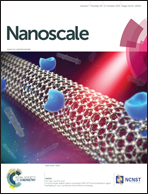Thin-walled SnO2 nanotubes functionalized with Pt and Au catalysts via the protein templating route and their selective detection of acetone and hydrogen sulfide molecules†
Abstract
Bio-inspired Pt (∼2 nm) and Au (∼2.7 nm) catalysts encapsulated by a protein shell, i.e., Pt-apoferritin (Pt@AF) and Au-apoferriten (Au@AF), were synthesized via the hollow protein nanocage (apoferritin) templating route and directly functionalized on the interior and exterior walls of electrospun SnO2 nanotubes (NTs) during controlled single-nozzle electrospinning followed by high temperature calcination with heating rate control. Fast crystallization of the exterior shell and outward diffusion of the interior Sn precursors and crystallites result in the continued growth of a tubular wall, which is related to rapid heating driven Ostwald-ripening behavior. Very importantly, the Pt and Au nanoparticles (NPs) were immobilized onto thin-walled SnO2 NTs with a diameter of ∼350 nm and a shell thickness of ∼40 nm without any aggregation of catalysts due to high dispersibility, which originated from repulsive electrostatic (Coulombic) forces acting on the surface charged protein shells, leading to an enhanced catalytic effect and outstanding gas sensing properties. Pt-loaded SnO2 NTs exhibited superior acetone response (Rair/Rgas = 92 at 5 ppm) compared to pure SnO2 NFs (Rair/Rgas = 4.8 at 5 ppm) and SnO2 NTs (Rair/Rgas = 11 at 5 ppm) while Au-loaded SnO2 NTs showed a high response when exposed to hydrogen sulfide (Rair/Rgas = 34 at 5 ppm), offering selective gas detection with minimal cross-sensitivity against other interfering gases such as NH3, CO, NO, C6H5CH3, and C5H12. Our results provide a new insight into facile, cost-effective, and highly dispersible catalyst loading on the interior and exterior walls of hollow metal oxide NTs via simple electrospinning as a potential breath analyzer.


 Please wait while we load your content...
Please wait while we load your content...